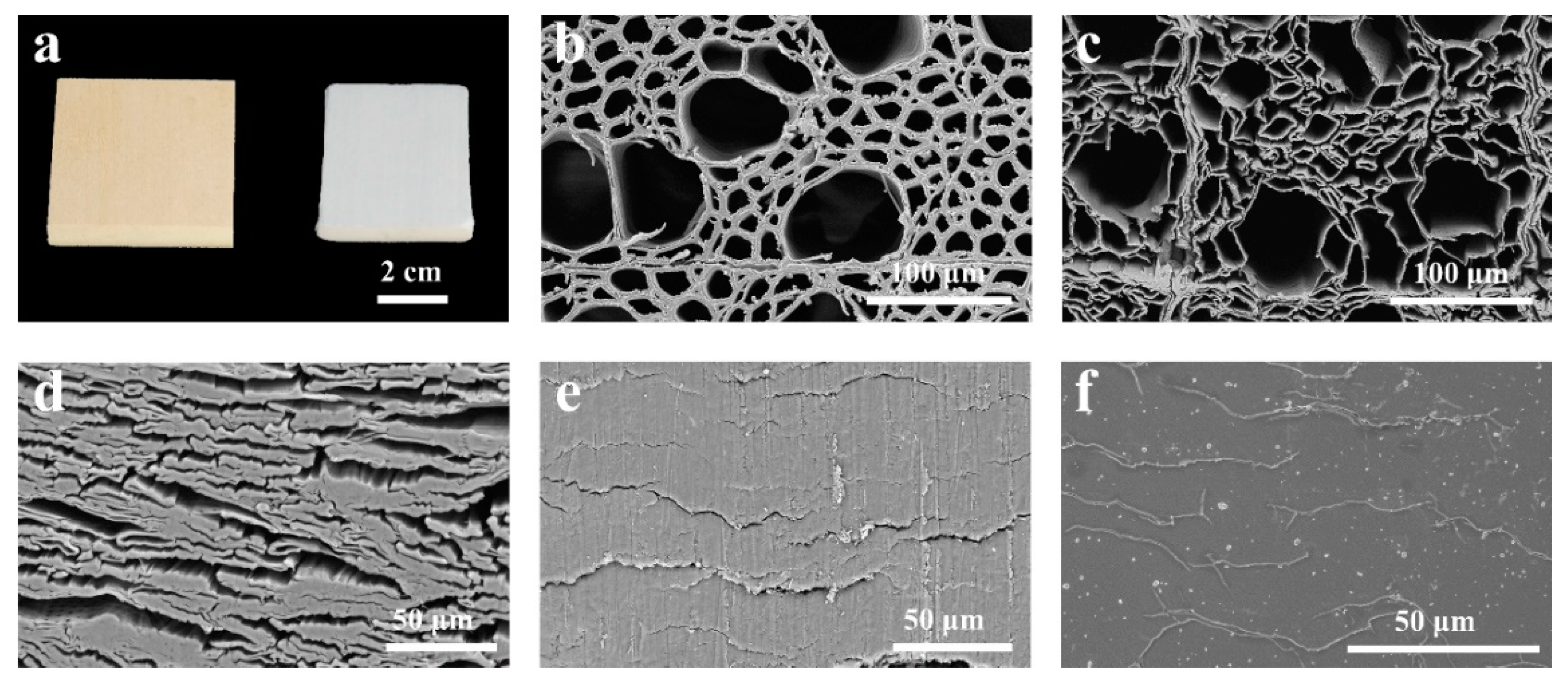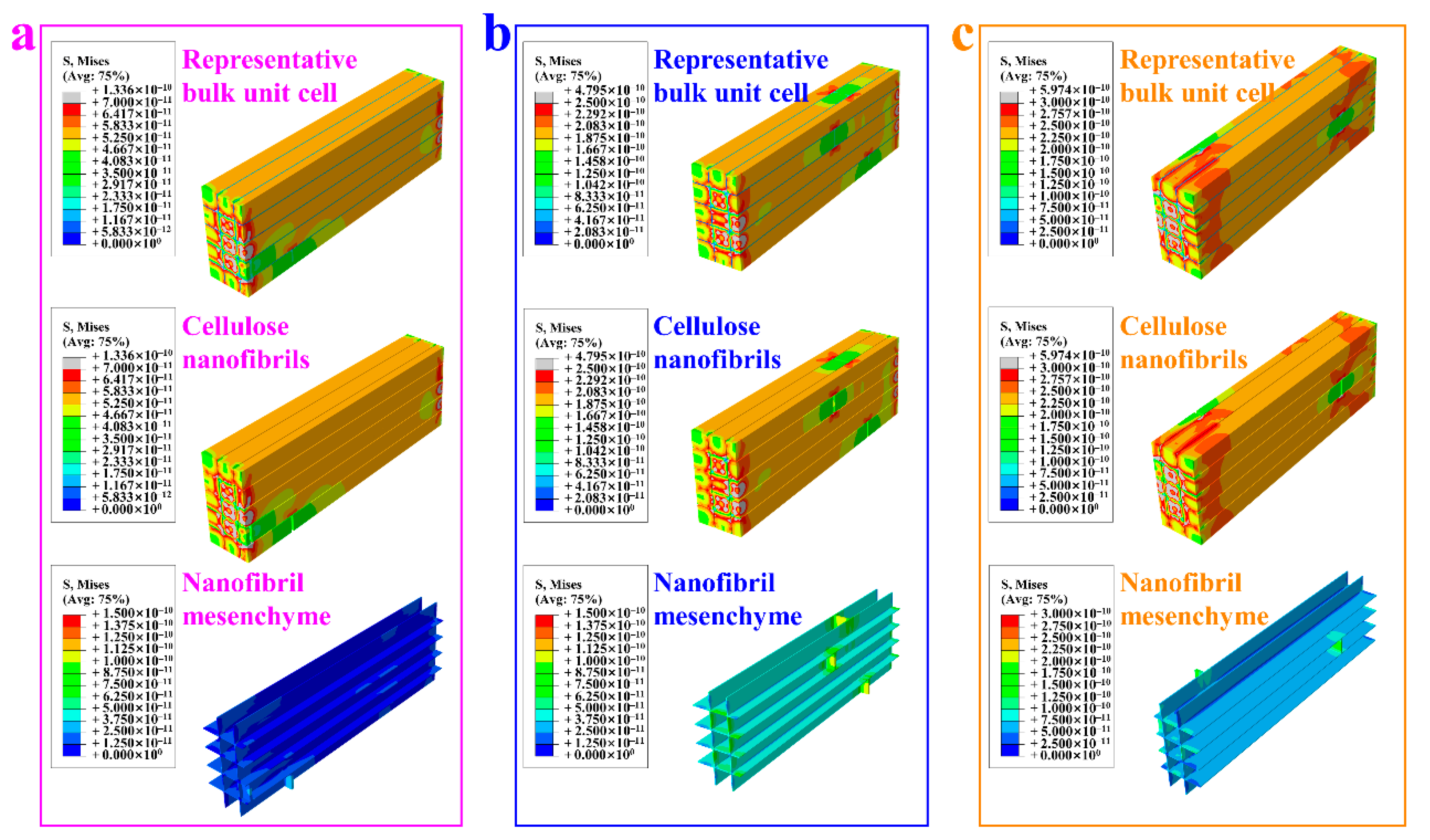Finite Element Analysis of Strengthening Mechanism of Ultrastrong and Tough Cellulosic Materials
Abstract
1. Introduction
2. Materials and Methods
2.1. Materials and Chemicals
2.2. Fabrication of Ultrastrong and Tough Cellulose Nanofibril Bulk Material
2.3. Characterization
2.4. Numerical Modeling of Ultrastrong and Tough Bulk Material
3. Results
4. Conclusions
Supplementary Materials
Author Contributions
Funding
Institutional Review Board Statement
Data Availability Statement
Acknowledgments
Conflicts of Interest
References
- Xia, L.L.; Tu, H.J.; Zeng, W.; Yang, X.L.; Zhou, M.; Li, L.K.; Guo, X. A room-temperature self-healing elastomer with ultra-high strength and toughness fabricated via optimized hierarchical hydrogen-bonding interactions. J. Mater. Chem. A 2022, 10, 4344–4354. [Google Scholar] [CrossRef]
- Duan, G.; Jin, M.; Wang, F.; Greiner, A.; Agarwal, S.; Jiang, S. Core effect on mechanical properties of one dimensional electrospun core-sheath composite fibers. Compos. Commun. 2021, 25, 100773. [Google Scholar] [CrossRef]
- Zhou, X.; Ding, C.; Cheng, C.; Liu, S.; Duan, G.; Xu, W.; Liu, K.; Hou, H. Mechanical and thermal properties of electrospun polyimide/rGO composite nanofibers via in-situ polymerization and in-situ thermal conversion. Eur. Polym. J. 2020, 141, 110083. [Google Scholar] [CrossRef]
- Williams, J.C.; Starke Jr, E.A. Progress in structural materials for aerospace systems. Acta Mater. 2003, 51, 5775–5799. [Google Scholar] [CrossRef]
- Wu, G.; Sun, J.; Huang, C.; Ren, H.; Zhao, R. Research progress on mechanical properties of tenon-mortise joints in traditional Chinese wood structures. J. For. Eng. 2020, 5, 29–37. [Google Scholar]
- Wang, D.; Yu, J.; Duan, G.; Liu, K.; Hou, H. Electrospun polyimide nonwovens with enhanced mechanical and thermal properties by addition of trace plasticizer. J. Mater. Sci. 2020, 55, 5667–5679. [Google Scholar] [CrossRef]
- Lin, X.H.; Zhang, L.N.; Duan, B. Polyphenol-mediated chitin self-assembly for constructing a fully naturally resourced hydrogel with high strength and toughness. Mater. Horiz. 2021, 8, 2503–2512. [Google Scholar] [CrossRef]
- Chen, L.; Cao, S.; Huang, L.; Wu, H.; Hu, H.; Liu, K.; Lin, S. Development of bamboo cellulose preparation and its functionalization. J. For. Eng. 2021, 6, 1–13. [Google Scholar]
- Li, T.; Chen, C.J.; Brozena, A.H.; Zhu, J.Y.; Xu, L.X.; Driemeier, C.; Dai, J.Q.; Rojas, O.J.; Isogai, A.; Wagberg, L.; et al. Developing fibrillated cellulose as a sustainable technological material. Nature 2021, 590, 47–56. [Google Scholar] [CrossRef]
- Moon, R.J.; Martini, A.; Nairn, J.; Simonsen, J.; Youngblood, J. Cellulose nanomaterials review: Structure, properties and nanocomposites. Chem. Soc. Rev. 2011, 40, 3941–3994. [Google Scholar] [CrossRef]
- Han, X.S.; Ding, L.H.; Tian, Z.W.; Wu, W.J.; Jiang, S.H. Extraction and characterization of novel ultrastrong and tough natural cellulosic fiber bundles from manau rattan (Calamus manan). Ind. Crops Prod. 2021, 173, 114103. [Google Scholar] [CrossRef]
- Han, X.S.; Wang, J.B.; Wang, J.W.; Ding, L.H.; Zhang, K.; Han, J.Q.; Jiang, S.H. Micro- and nano-fibrils of manau rattan and solvent-exchange-induced high-haze transparent holocellulose nanofibril film. Carbohydr. Polym. 2022, 298, 120075. [Google Scholar] [CrossRef] [PubMed]
- Cai, S.; Li, Y.; Huang, Y.; Guo, Y. Study on correlation between mechanical measurement of wood cell wall and added load by nano-indentation. J. For. Eng. 2021, 6, 64–71. [Google Scholar]
- Ji, F.; Sun, Z.; Hang, T.; Zheng, J.; Li, X.; Duan, G.; Zhang, C.; Chen, Y. Flexible piezoresistive pressure sensors based on nanocellulose aerogels for human motion monitoring: A review. Compos. Commun. 2022, 35, 101351. [Google Scholar] [CrossRef]
- Dufresne, A. Nanocellulose: From Nature to High Performance Tailored Materials; Walter de Gruyter GmbH & Co KG: Berlin, Germany, 2017. [Google Scholar]
- Sturcova, A.; Davies, G.R.; Eichhorn, S.J. Elastic modulus and stress-transfer properties of tunicate cellulose whiskers. Biomacromolecules 2005, 6, 1055–1061. [Google Scholar] [CrossRef]
- Zhu, H.L.; Zhu, S.Z.; Jia, Z.; Parvinian, S.; Li, Y.Y.; Vaaland, O.; Hu, L.B.; Li, T. Anomalous scaling law of strength and toughness of cellulose nanopaper. Proc. Natl. Acad. Sci. USA 2015, 112, 8971–8976. [Google Scholar] [CrossRef]
- Li, K.; Skolrood, L.N.; Aytug, T.; Tekinalp, H.; Ozcan, S. Strong and Tough Cellulose Nanofibrils Composite Films: Mechanism of Synergetic Effect of Hydrogen Bonds and Ionic Interactions. ACS Sustain. Chem. Eng. 2019, 7, 14341–14346. [Google Scholar] [CrossRef]
- Song, J.W.; Chen, C.J.; Zhu, S.Z.; Zhu, M.W.; Dai, J.Q.; Ray, U.; Li, Y.J.; Kuang, Y.D.; Li, Y.F.; Quispe, N.; et al. Processing bulk natural wood into a high-performance structural material. Nature 2018, 554, 224–228. [Google Scholar] [CrossRef]
- Wang, Q.Q.; Yao, Q.; Liu, J.; Sun, J.Z.; Zhu, Q.Q.; Chen, H.L. Processing nanocellulose to bulk materials: A review. Cellulose 2019, 26, 7585–7617. [Google Scholar] [CrossRef]
- Zhao, K.X.; Wang, W.H.; Teng, A.G.; Zhang, K.; Ma, Y.H.; Duan, S.M.; Li, S.Z.; Guo, Y. Using cellulose nanofibers to reinforce polysaccharide films: Blending vs layer-by-layer casting. Carbohydr. Polym. 2020, 227, 115264. [Google Scholar] [CrossRef]
- Xiao, J.; Li, H.; Zhang, H.; He, S.; Zhang, Q.; Liu, K.; Jiang, S.; Duan, G.; Zhang, K. Nanocellulose and its derived composite electrodes toward supercapacitors: Fabrication, properties, and challenges. J. Bioresour. Bioprod. 2022. [Google Scholar] [CrossRef]
- Benitez, A.J.; Walther, A. Counterion Size and Nature Control Structural and Mechanical Response in Cellulose Nanofibril Nanopapers. Biomacromolecules 2017, 18, 1642–1653. [Google Scholar] [CrossRef] [PubMed]
- Benitez, A.J.; Walther, A. Cellulose nanofibril nanopapers and bioinspired nanocomposites: A review to understand the mechanical property space. J. Mater. Chem. A 2017, 5, 16003–16024. [Google Scholar] [CrossRef]
- Huang, D.; Li, D.; Mo, K.W.; Xu, R.; Huang, Y.A.; Cui, Y.D.; Zhang, Q.C.; Chang, C.Y. Top-down fabrication of biodegradable multilayer tunicate cellulose films with controlled mechanical properties. Cellulose 2021, 28, 10415–10424. [Google Scholar] [CrossRef]
- Garemark, J.; Yang, X.; Sheng, X.; Cheung, O.; Sun, L.C.; Berglund, L.A.; Li, Y.Y. Top-Down Approach Making Anisotropic Cellulose Aerogels as Universal Substrates for Multifunctionalization. ACS Nano 2020, 14, 7111–7120. [Google Scholar] [CrossRef] [PubMed]
- Zhu, M.W.; Jia, C.; Wang, Y.L.; Fang, Z.Q.; Dai, J.Q.; Xu, L.S.; Huang, D.F.; Wu, J.Y.; Li, Y.F.; Song, J.W.; et al. Isotropic Paper Directly from Anisotropic Wood: Top-Down Green Transparent Substrate Toward Biodegradable Electronics. ACS Appl. Mater. Interfaces 2018, 10, 28566–28571. [Google Scholar] [CrossRef] [PubMed]
- Zou, Y.; Zhao, J.; Zhu, J.; Guo, X.; Chen, P.; Duan, G.; Liu, X.; Li, Y. A Mussel-Inspired Polydopamine-Filled Cellulose Aerogel for Solar-Enabled Water Remediation. ACS Appl. Mater. Interfaces 2021, 13, 7617–7624. [Google Scholar] [CrossRef]
- Li, T.; Zhai, Y.; He, S.M.; Gan, W.T.; Wei, Z.Y.; Heidarinejad, M.; Dalgo, D.; Mi, R.Y.; Zhao, X.P.; Song, J.W.; et al. A radiative cooling structural material. Science 2019, 364, 760–763. [Google Scholar] [CrossRef]
- Zhu, M.W.; Wang, Y.L.; Zhu, S.Z.; Xu, L.S.; Jia, C.; Dai, J.Q.; Song, J.W.; Yao, Y.G.; Wang, Y.B.; Li, Y.F.; et al. Anisotropic, Transparent Films with Aligned Cellulose Nanofibers. Adv. Mater. 2017, 29, 1606284. [Google Scholar] [CrossRef]
- Neves, R.M.; Ornaghi, H.L.; Zattera, A.J.; Amico, S.C. Recent studies on modified cellulose/nanocellulose epoxy composites: A systematic review. Carbohydr. Polym. 2021, 255, 117366. [Google Scholar] [CrossRef]
- Chen, Q.H.; Jiang, Z.Y.; Pei, X.X.; Liu, Y.Q.; Du, R.K.; Zhao, G.Z. Bio-inspired, epoxy-based lamellar composites with superior fracture toughness by delignified wood scaffold. Compos. Sci. Technol. 2021, 207, 108739. [Google Scholar] [CrossRef]
- Kuai, B.B.; Wang, Z.H.; Gao, J.S.; Tong, J.W.; Zhan, T.Y.; Zhang, Y.L.; Lu, J.X.; Cai, L.P. Development of densified wood with high strength and excellent dimensional stability by impregnating delignified poplar by sodium silicate. Constr. Build. Mater. 2022, 344, 128282. [Google Scholar] [CrossRef]
- Han, X.S.; Ye, Y.H.; Lam, F.; Pu, J.W.; Jiang, F. Hydrogen-bonding-induced assembly of aligned cellulose nanofibers into ultrastrong and tough bulk materials. J. Mater. Chem. A 2019, 7, 27023–27031. [Google Scholar] [CrossRef]
- Hu, W.G.; Chen, B.R.; Zhang, T.X. Experimental and numerical studies on mechanical behaviors of beech wood under compressive and tensile states. Wood Res. 2021, 66, 27–37. [Google Scholar] [CrossRef]
- Valachova, D.; Skotnicova, I. Using the finite element method to predict heat dissipation in a timber frame building construction. Wood Res. 2019, 64, 859–870. [Google Scholar]
- Hu, W.G.; Chen, B.R. A Methodology for Optimizing Tenon Geometry Dimensions of Mortise-and-Tenon Joint Wood Products. Forests 2021, 12, 478. [Google Scholar] [CrossRef]
- Hu, W.G.; Wan, H.; Guan, H.Y. Size Effect on the Elastic Mechanical Properties of Beech and Its Application in Finite Element Analysis of Wood Structures. Forests 2019, 10, 783. [Google Scholar] [CrossRef]
- Sluiter, A.; Hames, B.; Ruiz, R.; Scarlata, C.; Sluiter, J.; Templeton, D.; Crocker, D.; Templeton, D. Determination of structural carbohydrates and lignin in biomass. Lab. Anal. Proced. 2008, 1617, 1–16. [Google Scholar]
- Klemm, D.; Kramer, F.; Moritz, S.; Lindstrom, T.; Ankerfors, M.; Gray, D.; Dorris, A. Nanocelluloses: A New Family of Nature-Based Materials. Angew. Chem. Int. Ed. 2011, 50, 5438–5466. [Google Scholar] [CrossRef]






Publisher’s Note: MDPI stays neutral with regard to jurisdictional claims in published maps and institutional affiliations. |
© 2022 by the authors. Licensee MDPI, Basel, Switzerland. This article is an open access article distributed under the terms and conditions of the Creative Commons Attribution (CC BY) license (https://creativecommons.org/licenses/by/4.0/).
Share and Cite
Han, X.; Wang, J.; Wang, X.; Tian, W.; Dong, Y.; Jiang, S. Finite Element Analysis of Strengthening Mechanism of Ultrastrong and Tough Cellulosic Materials. Polymers 2022, 14, 4490. https://doi.org/10.3390/polym14214490
Han X, Wang J, Wang X, Tian W, Dong Y, Jiang S. Finite Element Analysis of Strengthening Mechanism of Ultrastrong and Tough Cellulosic Materials. Polymers. 2022; 14(21):4490. https://doi.org/10.3390/polym14214490
Chicago/Turabian StyleHan, Xiaoshuai, Jingwen Wang, Xiaoyi Wang, Wei Tian, Yanyan Dong, and Shaohua Jiang. 2022. "Finite Element Analysis of Strengthening Mechanism of Ultrastrong and Tough Cellulosic Materials" Polymers 14, no. 21: 4490. https://doi.org/10.3390/polym14214490
APA StyleHan, X., Wang, J., Wang, X., Tian, W., Dong, Y., & Jiang, S. (2022). Finite Element Analysis of Strengthening Mechanism of Ultrastrong and Tough Cellulosic Materials. Polymers, 14(21), 4490. https://doi.org/10.3390/polym14214490








